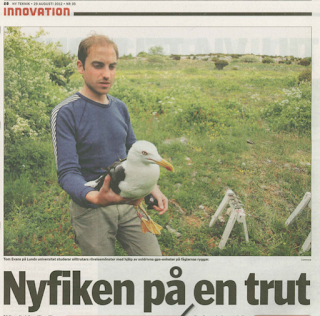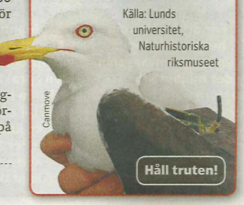 |
| Tom Evans during fieldwork at Stora Karlsö this summer. |
onsdag 29 augusti 2012
CAnMove research in today's "Ny teknik"
måndag 20 augusti 2012
The Behavioural Ecology of Animal Movement
Following last week's ISBE2012 conference, hosted by Lund University, we ended the week with a CAnMove symposium on the behavioural ecology of animal movement.
It was a great day with a lively and highly diverse group of people from all over the world working on all sorts of disciplines related to behavioural movement ecology.
The breadth and diversity of the topic was apparent from the plenary talks we listened to, covering different magnitudes of tracking distance and movement patterns, looking at behavioural strategy and responses of both wild but also caged animals. Questions addressed covered: What are the sensory processes? How does ecology shape group strategies and sociality and vice versa? (How) does this differ in different habitat and for different species and communities? How does the underlying genetic architecture of these movement traits look like?
In addition to highly inspiring talks, we enjoyed ample opportunity for poster presentations, discussions and change of ideas, which we then synthesized in a final plenary discussion - before ending this day in glorious sunshine with delicious dinner at Kulturen.
Thanks to all of you, making this symposium a real highlight.
fredag 10 augusti 2012
Spotty cows avoid horsefly bites
| "Fjällko" Photo: Susanne Åkesson |
A warm
summer day the air is full of insects, such as pollinators, butterflies and blood
sucking dipterans. Tabanid flies (or horse files) can in many areas be an
annoying pest to grazing horses and cattle. The horse flies bite to suck blood
from the mammalian host and use the blood meal to produce eggs. These eggs are
later attached to vegetation near to water and ponds, in which the larvae
develop. The tabanid flies can see reflected linearly polarized light and use
this information to locate water and mammalian hosts. In a recent paper published
in PLoS ONE we demonstrate that the coat pattern of cattle is crucial in attracting
the biting flies, such that the more spots you have the less attractive you
are. Cattle have been bread to increase meat and milk production, with limited
focus on coat pattern appearance. However, for the future we suggest that also
this feature should be considered in cattle farming in order to minimize spread
of diseases to cattle and to minimize disturbance during grazing. It is
interesting to note the typical coat pattern of the ancient Swedish cow race “fjällko”
(photo above), which seem to have an ideal coat pattern in order to avoid
horsefly bites – predominantly white with black spots.
Susanne
Prenumerera på:
Inlägg (Atom)


